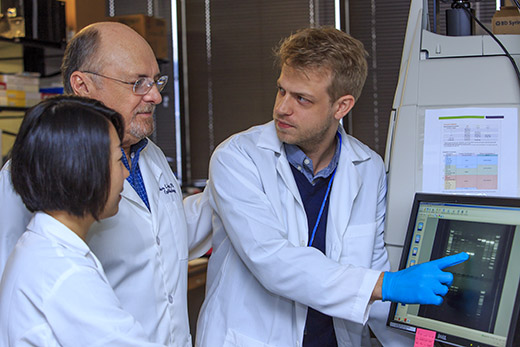Research led by Emory Eye Center scientist Eldon E. Geisert, PhD, shows that a protein that affects corneal thickness might also be connected to glaucoma risk.
The study, conducted on mice, found that variations in the genes that code for a protein called POU6F2 correlated with corneal thickness. In the developing eye, nerve cells of the retina and cells of the cornea express POU6F2. When the researchers removed the gene that codes for POU6F2, the mice had thinner corneas than normal mice. They also learned that POU6F2 helps regulate the developing cornea and helps keep it healthy by replenishing corneal stems cells in adult mice.
In glaucoma, pressure builds in the eye and damages the optic nerve. If left untreated, glaucoma may ultimately lead to blindness. Thinner corneas are a well-known risk factor for one variation of the disease – primary open angle glaucoma (POAG). Geisert’s group demonstrated that the cells expressing POU6F2 are the most sensitive to injury. In collaboration with other research groups studying the human risk factors for glaucoma, POU6F2 is a good candidate for glaucoma risk in humans.
“We were very surprised by our findings,” Geisert says. “Almost everyone believes that the link between central corneal thickness and glaucoma is due to stiffness of the cornea and sclera – not because of a protein such as POU6F2 which controls gene expression. Thus, the link was not immediately obvious.”
“The specific role many proteins play in our body may differ from tissue to tissue,” he continues. “In the cornea, POU6F2 is involved with tissue development and marks the stem cells that maintain corneal integrity. But it appears to have a completely different role in the retina.”
Current research efforts are attempting to understand how POU6F2 might regulate the eye’s structure and increase a person’s risk of glaucoma. “Things we learn about POU6F2 and retinal ganglion cell susceptibility to injury may provide unique insights into methods to treat early phases of glaucoma,” he says.
“Glaucoma is a complex disease with many genetic and environmental factors influencing the patient population,” Geisert adds. “We hope that defining this link between central corneal thickness and glaucoma – and other aspects of POU6F2 – will aid in early detection of glaucoma and eventually lead to treatments that can halt the progression of this disease.”
Emory Eye Center
The Emory Eye Center is the largest, most comprehensive eye care facility in Georgia, serving patients for more than 125 years. Physicians from across the globe seek residency and fellowship training at the Center from our internationally-renowned clinical and basic science faculty. Scientists at Emory Eye Center are researching the causes of and improved treatments for macular degeneration, cataracts, glaucoma, genetic eye diseases and more. Innovative treatments, groundbreaking research and personalized care have earned Emory Eye Center the respect of patients and providers alike. To learn more, visit www.eyecenter.emory.edu.

